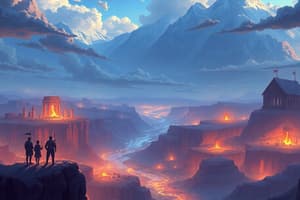Podcast
Questions and Answers
Who is North America named after?
Who is North America named after?
North America is named after Italian explorer Amerigo Vespucci.
When did Christopher Columbus discover North America?
When did Christopher Columbus discover North America?
Christopher Columbus is considered to have discovered North America in 1492 CE while he was trying to find a new sea route to India.
Which European seamen visited North America before Christopher Columbus?
Which European seamen visited North America before Christopher Columbus?
The Norsemen and the Vikings visited North America as early as 986 CE.
What is the latitudinal extent of North America?
What is the latitudinal extent of North America?
What is the highest point in North America?
What is the highest point in North America?
Who is considered to have discovered North America in 1492 CE?
Who is considered to have discovered North America in 1492 CE?
What is the latitudinal extent of North America?
What is the latitudinal extent of North America?
What is the longitudinal extent of North America?
What is the longitudinal extent of North America?
What are the names of the major rivers in North America?
What are the names of the major rivers in North America?
Name the mountain ranges present in North America.
Name the mountain ranges present in North America.
Flashcards are hidden until you start studying
Study Notes
North America: Key Geographic and Historical Facts
- The continent of North America is named after Italian explorer Amerigo Vespucci, who reached it in 1507 CE.
- Christopher Columbus is considered to have discovered North America in 1492 CE while seeking a new sea route to India.
- European seamen, such as the Norsemen and Vikings, had visited the continent as early as 986 CE.
- North America, along with South America, is referred to as the New World due to their discovery in the 15th century.
- North America's latitudinal extent ranges from 12º N to 85º N, and its longitudinal extent ranges from 20º W to 180º W.
- The continent covers an area of approximately 24 million square kilometers, making it the third largest.
- North America has a coastline length of 148,330 kilometers, with its highest point being Mt. McKinley in Alaska (6,194 meters) and lowest point being Death Valley in California (86 meters below sea level).
- The continent spans a maximum length of 7,200 kilometers from Panama to the Arctic Islands and a maximum width of 4,800 kilometers between British Columbia and Newfoundland.
- Major rivers in North America include the Mississippi-Missouri, Rio Grande, and Mackenzie, while major lakes include the Great Lakes (Superior, Michigan, Huron, Erie, and Ontario) as well as Great Slave and Great Bear.
- North America features mountain ranges such as the Western Cordilleras (Rockies, Alaska, Cascade, Sierra Nevada, Sierra Madre) and the Appalachians.
- The continent's discovery by Columbus in 1492 CE is widely accepted, despite earlier visits by European seamen.
- North America and South America are collectively known as the New World due to their discovery in the 15th century.
Studying That Suits You
Use AI to generate personalized quizzes and flashcards to suit your learning preferences.




